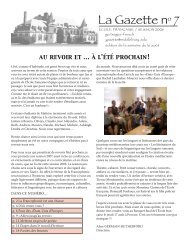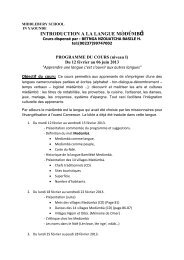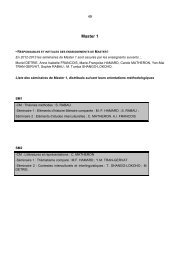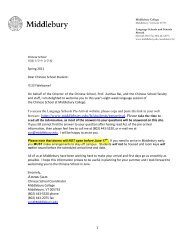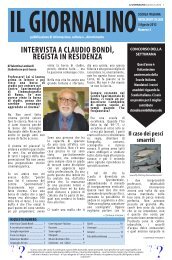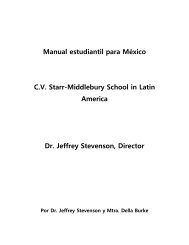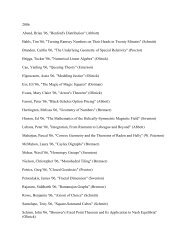2012 Summer Symposium Program - Middlebury College
2012 Summer Symposium Program - Middlebury College
2012 Summer Symposium Program - Middlebury College
Create successful ePaper yourself
Turn your PDF publications into a flip-book with our unique Google optimized e-Paper software.
Page 18<br />
21<br />
Wisath Sae-Lee (Momo) ‘13<br />
Major: BIOCHEM<br />
National Science Foundation<br />
(Larrabee)<br />
Jim Larrabee<br />
William R. Kenan Jr. Professor<br />
of Chemistry<br />
<strong>Middlebury</strong> <strong>Summer</strong> Research <strong>Symposium</strong> <strong>2012</strong><br />
separate magnetic minerals. The remaining non-magnetic fraction was run through<br />
heavy liquid separation, using Methylene Iodide which has a density of 3.3 g/cm 3<br />
to collect minerals that were higher in density—zircon has a density of ~4.6 g/cm 3 .<br />
Pyrite also has a higher density, close to 5 g/cm 3 , and so some samples were reacted<br />
in strong hydrofluoric acid baths to dissolve minerals other than zircons. Collected<br />
zircons were then mounted in epoxy and polished for use in the scanning electron<br />
microscope (SEM) and, later in the summer, the electron microprobe (EMP) at RPI<br />
in Troy, NY for cathodoluminescence (CL) imaging. The laser ablation inductively<br />
coupled plasma mass spectrometer (LA-ICP-MS) at RPI will be used to date a<br />
random selection of ~80 detrital grains from each sample, by comparing the ratios<br />
of uranium and lead isotopes to a standard. Geochemical and petrographic data for<br />
each sample will be found using the ICAP spectrometer at <strong>Middlebury</strong> and by thin<br />
section analysis. Further sampling and analysis farther north in the Craftsbury area<br />
may provide insight into variability along the length of the formation.<br />
Comparative MCD study of DapE-Encoded<br />
N-Succinyl-l,l-Diaminopimelic Acid<br />
Desuccinylase (DapE) from Haemophilus influenza<br />
and Neisseria meningitides<br />
Wisath Sae-Lee (Momo) and Jim Larrabee<br />
Department of Chemistry and Biochemistry, <strong>Middlebury</strong> <strong>College</strong>, <strong>Middlebury</strong> VT 05753<br />
DapE-Encoded N-Succinyl-l,l-Diaminopimelic Acid Desuccinylase (DapE) plays<br />
an integral role in the biosynthesis of lysine (Lys) and meso-diaminopimelic acid<br />
(mDAP). These biosynthetic processes provide essential components for both<br />
protein synthesis and the construction of peptidoglycan in the bacterial cell wall.<br />
Previous gene knock-out studies showed that the deletion of DapE gene induced<br />
lethality even in lysine-supplemented media, suggesting that lysine cannot be<br />
imported by other pathways. Since the lysine biosynthetic pathway is distinctive<br />
to most gram-negative and some gram-positive bacteria, inhibitors of DapE could<br />
provide selective bacterial toxicity. In this work, DapEs from Haemophilus influenza<br />
(HiDapE) and Neisseria meningitides (NmDapE) were studied with various equivalents<br />
of Co(II) with and without two different inhibitors—Caprtopril and Dithiothreitol<br />
(DTT)—using magnetic circular dichroism (MCD). The result from the study of<br />
the DapEs with Co(II) showed the electronic geometry of the two binding sites to<br />
be 4- and 6-coordinate which have not been found in any other metalloenzymes.<br />
The affinities of both sites in NmDapE appeared to be the same while the affinity of<br />
the 4-coordinate site was higher than the 6-coordinate site for HiDapE. The MCD<br />
spectra showed both inhibitors to be antiferromagnetically couple with the two<br />
metals through a sulfide bridge.





